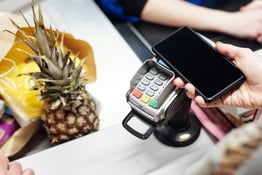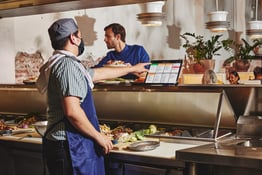The evolution of food tech hews closely to the history of fast food. The concept of dishing out ready-made cravings to diners on the fly finds its roots in ancient Rome. There, plebs flocked to joints called thermpolia to order workaday faves at a counter that housed jars called dolia that stored dried delicacies. Roughly two millennia later, the Germans rounded out their industrial revolution with the pioneering Automat, where kitchen staff loaded meals into vending machines that dispensed these affordable offerings to customers with a penchant for the pre-prepared.
Historians trace the inception of fast food in its current form to 1921 and the establishment of the first White Castle. When founders Walt Anderson and Billy Ingram made the hamburger the quintessential American indulgence, they did so using a patented supply chain called the White Castle system, transport boxes engineered for stackability, and plenty of stainless steel.
Today if you want to see the best of restaurant tech, you can skip the earthenware jugs and nickel exchange booths and instead admire Flippy the Robot’s skills at the White Castle grill. Quick-serve and fast-casual restaurants, as ever, remain a hotbed of tech solutions. National brands love to tout their bespoke innovations — for some of us, the 2008 Super Bowl will forever be remembered as the day we saw three Domino’s Pizza Tracker commercials in a row — but in many regards, the industry has found a handful of go-to technologies that keep your fast food faves humming along, in some cases, no matter where you go.
To get an overview of the entire sector at present, we spoke to Science on Call’s Ayden Walker, a support agent at Science and the restaurant IT help desk’s resident “QSR overlord.” With his help we drilled into the technologies that make fast food so enduring.
The most popular fast-food restaurant point-of-sale systems
If there’s one thing we learned from breaking down on-premise vs. cloud-based point-of-sale systems, it’s that no one POS fits all restaurants. Proponents of the on-premise systems are often legacy brands or establishments, who either prefer or don’t want to switch from a system that stores their data physically at the restaurant. The newer cloud-based POS systems send your restaurant's data into the cloud, which is more ephemeral but promises more layers to back up that data.
Fast food restaurants in particular, though, tend to rely on some standout favorite systems.
“The most common POS you encounter in fast food restaurants is NCR Aloha, or some in-house version of it,” Walker tells us. “Fast food places stand in contrast to what you might call ‘sit-down Toast restaurants,’ which don’t have a centralized POS server hub because they’re using cloud technology. A lot of QSRs, even the more recently established ones, are still following the legacy model of having the register data go to an on-premise server, where it’s stored and kept for reporting.”
Why is that, in a moment when cloud systems grab an increasing share of the POS market? “Aloha isn’t cutting-edge by any means, but it has a lot of history within this particular sub-industry of food service,” says Walker. “It’s considered to be pretty reliable, especially hardware-wise. A lot of the time you see it paired with the NCR XR 7, which is really durable.” Hardiness is a must-have when it comes to the tech in fast food restaurants, which are traversed daily by dozens of employees processing astronomical sales volumes on the daily. And for many operators, the on-premise server itself remains attractive. “There’s a psychological comfort involved in knowing where exactly your sales data is. If you’re an owner-operator of a McDonald’s, you don’t want the $15,000 worth of transactions you did today disappearing off into the void. Because if you’re not familiar with cloud technology, that’s what it’ll seem like to you.”
Walker says that another reason the household cloud names have struggled to find a foothold is that platforms like Square and Toast aren’t optimized for certain needs unique to fast food. “Toast’s multi-location features are designed around the idea of a uniform menu across all locations, and you don’t always have that in the case of a franchised QSR chain. Franchise owners are typically free to manage their locations’ menus within the confinements that are set in place by the franchisor. They can say ‘No, we don’t want to serve X,’ and until recently, it was impossible to arrange that with Toast.” While Toast in particular is expanding its capabilities in an effort to horn in on the lucrative QSR market, we’ve written about how logistically difficult it can be to make that sidegrade, and for a lot of owner-operators, it comes down to the simple adage, “if it ain’t broke, don’t fix it.”
So, we’ve got durability, multi-location menu management, and on-premise data storage — what other qualities does a QSR POS system have to possess to be top-notch? To get a sense of the necessary characteristics, just look at how the McDaddy of all fast food joints does it. Since 2008, McDonald’s has used a proprietary system called NP6 to get the job done. Employees key in orders on a panoramic touchscreen bedecked with tappable color photos of menu items. The visual poetry of the NP6 is a universal language, accessible to the thousands of far-flung franchisees making up this multinational behemoth.
The flow of the interface is designed to mirror the natural unfolding of the cashier-customer conversation, prompting for size, flavor, and side selections, and it features a sophisticated “grill back” menu that makes it a snap to add, eliminate, or substitute ingredients — so you don’t have to worry about the kitchen garbling your extra-mayo, no-onions Big Mac. The NP6 is evolved enough to accommodate the most special of special orders, but should a customer dream up a combo too esoteric to be readily input, cashiers can alert grill staff through the use of the handy “Ask Me” key. Most importantly, the NP6 is built to withstand gargantuan sales volumes, and to communicate accurate and readable information to kitchen and customer-facing displays at every turn.
The best fast-food card readers and payment technology
As card readers go, one model dominates in the QSR space: the Verifone MX 915. “It is the card reader, in fast food,” Walker says. “One of the reasons it works so well there is that it can store and forward, or SAF, several thousands of dollars’ worth of transactions.”
In Walker’s experience, internet outages are relatively rare in the fast food world, but when they do happen, the potential for data loss is enormous. It’s important to have card readers that can store payment data when offline — and equally important to know that they do that, and how it works.
“If your card reader has a SAF function, and you restart it while it’s in offline mode, then, poof — you lose all your data,” Walker says. “A lot of people fall into that trap, because if your register is disconnected from the network, it might seem like a reasonable troubleshooting step to restart everything, and if you don’t know you’re SAFing, you’re sunk.”
So know your card reader. Better still, get some reliable backup internet. That way your devices won’t end up in offline mode, and your Wifi-dependent customers won’t gripe about having to use data to access your mobile app. Speaking of which …
Fast-food mobile apps turn coupons into games
The pandemic era has ensured that everyone and their grandmother has an opinion about third-party delivery apps. Scroll through your local DoorDash or Grubhub listings and you’ll see all the major players in fast food. They’re usually the ones paying for sponsored ads on these platforms (maybe because they’re the only ones making enough bank to afford the placement).
But the pioneering folks in the QSR space know the real money is in their own branded mobile apps. Since the dawn of the smartphone, fast food companies have battled for top spots in the App Store rankings, along the way birthing some jaw-dropping innovations: the aforementioned Domino’s Pizza Tracker, for one, and, for another, the BK Whopper Detour campaign, which used the powers of geofencing and push notifications to redirect would-be Big Mac snackers to Burger King, lured by a time-limited coupon for a one-cent Whopper. Consider that digital orders are, on average, 20% higher than traditional on-premise orders. Guests opt to pay a premium to customize their orders to the nines (sans aggravating a line full of hungry counter-hounds behind them) and to enjoy the ease of a virtual ordering concierge that stores their favorite Happy Meal presets for future reference.
Standard app fare consists of daily deals, point-based reward systems, and QR code-based check-in/pickup, but the sky really is the limit as companies promote consistent app use. Back in the ‘10s, brands sought to capitalize on the Angry Birds and Temple Run crazes by releasing their own mobile games. One would imagine the contemporary equivalent to be some kind of branded crypto mining platform (McThereum? Bitecoin?) to delight the teens and baffle their parents.
The sneaky tech of fast-food self-ordering kiosks
The statistics are clear on digital order-ahead technology and its growth potential. In recent years, though, QSRs like Mickey D’s and Panera have bet big on another contactless ordering solution: self-service kiosks.
The on-premise kiosk market is expected to reach $30.8 billion by 2024. As in the mobile case, kiosk orders tend to be more lucrative than those taken by a human cashier. One reason? The power of AI. Once again, McD’s has taken a pioneering tack in this area. Since 2018 the chain has used tech from a company called Dynamic Yield to upsell, personalize, and drive decision-making at kiosks and in drive-through lanes.
“By automating the ordering process, you alleviate a good bit of the employee workload,” says Walker. “When you don’t have to designate a ton of man-hours to customer service, workers can focus more on preparation and presentation, which is good for business overall.”
Fast-food kitchen technology has to be ridiculously durable
If you’ve waited at the walkup counter or snuck a peek through the drive-thru window while awaiting your order, you’ve seen the modern Kitchen Display Screen (KDS) in action. These wall-mounted screens display incoming orders, firing information, and recipes. Kitchens in contemporary fast food restaurants have KDS monitors at each prep station, most of which record and analyze data on average cook time, which is used to properly time and sequence orders. KDS systems also largely eliminate the need for wasteful and stainable paper tickets … but only largely.
“I warn QSR operators: Don’t cheap out on ticket and receipt printers,” says Walker. “You need those to be working for your special orders. If somebody orders a regular cheeseburger, you’ll just see that on the KDS — no ticket will print, because the wrapper is what distinguishes the cheeseburger from the hamburger and so on. But if you modify that menu item in any way — add extra ketchup, sub the bun — then the ticket is going to print, because that’s what’s going to distinguish that special cheeseburgers from the others in your order once everything ends up in the hot landing area.”
The cheaper the printer, the likelier Walker says it is to die in the middle of a shift, or to misfire when printing, leading to costly confusion once it’s time to bag and serve.
Walker warns that the KDS itself also need safeguarding. Fast food kitchens are places of salt, fat, acid, and heat — all of which are brutal for screens. Many KDS systems feature bump bars. Those are panels with buttons that allow cooks to interact with the KDS monitor, named for the act of “bumping” orders from one prep station’s KDS to the next. As the worker handles them, the bump bars get greasy fast, leading to a variety of problems. Walker recommends that restaurants invest in water-resistant technology for the parts of the screens that get the most wear, and to keep up preventative maintenance and cleaning.
Menu boards at fast-food places have to plug into a network
Your KDS and your POS aren’t the only screens you have to worry about in a fast food joint. In this advanced day and age, hefty monitors work overtime displaying menu items and prices with high-res photos to match.
There are two main types of digital menu boards in QSR restaurants: wall-mounted TV screens above the counter, and the outdoor vertical displays signaling the presence of a drive-thru. “A lot of McDonald’s and Popeye’s restaurants use a company called Stratacache,” Walker told us. “This is the kind of thing that franchisees have less control over. The tech vendors tend to be selected by the brands themselves, and you find that a lot of them are using the same ones.”
It’s imperative, he went on to explain, that these screens display accurate information. And it turns out that ensuring they behave as intended requires a strong network. Say you push a menu-wide price increase on your milkshakes. You change the price on your back end. From there it shows up on your POS. The menu boards must in turn pull those prices from the POS, so that the milkshake price on the big board matches the price at the register.
But if there’s a break in that chain? You’re in for a very bad shift. “Ideally, you’d give the customer the displayed price, and just eat the loss, but something like NCR Aloha doesn’t always let you change prices, so it’s really a huge problem,” Walker says. “Your options are to do a discount, which takes forever to calculate and input, or you promo it off and give it to the person for free. In all of those scenarios you lose money, so they’re against policy in some locations. In that case your only option is to say to the customer, ‘Sorry, I can’t sell you that.’ Which obviously looks terrible.”
Other fast-food business software to know
Menu board tech isn’t the only realm wherein fast food titans copy one other. Business software, too, is an area dominated by a handful of vendors. “McDonald’s and a number of its competitors use Altametrics for labor and sales reporting, as well as scheduling,” Walker says. “Xenial is also pretty popular for reporting. They actually offer lots of different products, like menu boards and POS systems, and so sometimes franchises will end up using them across the board because it’s easier. Restaurant365 is another one that’s used for multiple functions, from accounting to inventory. And Snagajob is prevalent for fast food staffing. McDonald’s has its own hiring platform, McHire, but most of the other major players are soliciting applications through Snag.”
[Photo by Shahbaz Ali on Unsplash]





